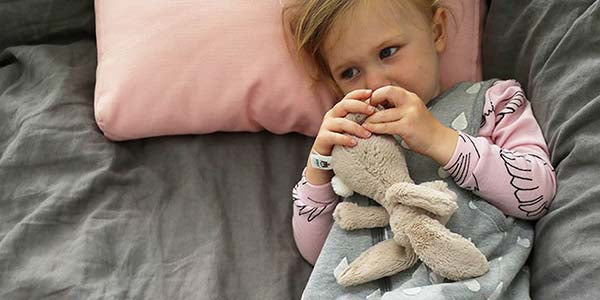
Are you confused about TOGS? As winter is fast approaching, we want to clear the confusion about TOG ratings and whether or not this is the right solution for keeping your child warm this winter.
What is TOG?
A TOG rating is a measure of the warmth of a garment or blanket when measured under different temperatures. When it comes to children’s sleepwear, the higher the TOG, the warmer the garment will keep your child at night.
TOG ratings are there to help parents judge and match their child’s sleepwear to the current bedroom temperature. Each brand of sleepwear will have a guide on how to dress your child underneath the garment depending on its TOG rating. It is also strongly recommended that the garment only be used within the recommended temperature range. Failing to do so means you are putting your child at risk of either being too hot or too cold for their bedroom environment.
Common guides for using TOGS
3.5 tog rating: suitable for winter for rooms with temps 12-16 degrees
2.5 tog rating: suitable for autumn/winter use for rooms with temps 16-20 degrees
1 tog rating: suitable for warm weather use for rooms with temps 20-24 degrees
This means parents could be purchasing 3 sleeping bags or sleepsuits per child for the year!
TOG ratings are dependent on a number of factors including the fibre composition of the sleeping bag, the weight of the fabric, the numbers of layers and the internal filling.
What is the relevance of fibre composition and TOGS?
A TOG rating not only indicates the warmth of a garment but also takes into account the breathability of the fibre from which it is made. This is an important factor in assessing its comfort and safety. The 3 most common fibres used in children’s sleepwear are polyester, cotton and bamboo.
High TOG sleeping bags with polyester content.
A typical 3.5 TOG sleeping bag is made of layers of cotton with a polyester fill inside.
The upside to polyester is that it is excellent at trapping in air and retaining warmth. The downside of polyester, being a synthetic fibre means that it is not breathable. When the room temperature fluctuates, or if the child gets too hot, the heat is unable to escape and this puts the child at risk of overheating.
Such a sleeping bag should only be used for extreme cold.
High TOG sleeping bags in cotton and bamboo
Both cotton and bamboo are natural fibres, which are ideal for children’s sleepwear because they are breathable and can reduce the risk of overheating. The downside is they have poor ability to retain heat. The only way to stay warm with cotton and bamboo is to bulk up with multiple layers of clothing. This can be impractical as well as uncomfortable for the child.
When my Georgia was 1, I did all the research on tog sleeping bags and ended up buying one in all the tog ratings. I was so paranoid about her overheating that I constantly went into her room to check her throughout the night. She kept waking up too hot or too cold. It was added stress I didn’t need.” Suzana Benfeito
If you choose a sleeping bag or sleepsuit with a TOG rating, you are strongly advised to follow the TOG guidelines to reduce the risk of both overheating and under heating. Both of these issues are enough to cause night time waking in young children.
Is there an alternative to TOGs?
The ideal alternative to choosing a sleepwear with TOGs is to choose one made from a natural fibre like Merino wool. Unlike cotton and bamboo, Merino wool has the unique ability to transfer moisture away from the body and cool it down once it starts to sweat.
Merino wool is warm, breathable and helps to keep your child’s body at a comfortable and constant temperature.
Merino wool can keep warm without the risk of overheating which eliminates the need for TOGs. This means it can be used across a wider range of temperatures and is not season-specific.
Simply by adjusting the layers underneath, a Merino wool sleeping bag or sleepsuit will naturally help regulate your child’s body temperature and keep it constant. This is conducive to a good night’s sleep.
It may seem like a bigger investment initially, but in Australia, a typical Merino wool sleeping bag can be used up to 10 months of the year! Following the temperature guide this makes it more versatile and effective in the long run and definitely something worth considering when buying your next sleeping bag this winter.
It is often underestimated how much your child’s sleepwear can influence how well they sleep. After all, a warm, comfortable sleep environment is the first step to ensuring a sound night’s sleep for the whole family.
Are you confused about TOGS? As winter is fast approaching, we want to clear the confusion about TOG ratings and whether or not this is the right solution for keeping your child warm this winter.
What is TOG?
A TOG rating is a measure of the warmth of a garment or blanket when measured under different temperatures. When it comes to children’s sleepwear, the higher the TOG, the warmer the garment will keep your child at night.
TOG ratings are there to help parents judge and match their child’s sleepwear to the current bedroom temperature. Each brand of sleepwear will have a guide on how to dress your child underneath the garment depending on its TOG rating. It is also strongly recommended that the garment only be used within the recommended temperature range. Failing to do so means you are putting your child at risk of either being too hot or too cold for their bedroom environment.
Common guides for using TOGS
3.5 tog rating: suitable for winter for rooms with temps 12-16 degrees
2.5 tog rating: suitable for autumn/winter use for rooms with temps 16-20 degrees
1 tog rating: suitable for warm weather use for rooms with temps 20-24 degrees
This means parents could be purchasing 3 sleeping bags or sleepsuits per child for the year!
TOG ratings are dependent on a number of factors including the fibre composition of the sleeping bag, the weight of the fabric, the numbers of layers and the internal filling.
What is the relevance of fibre composition and TOGS?
A TOG rating not only indicates the warmth of a garment but also takes into account the breathability of the fibre from which it is made. This is an important factor in assessing its comfort and safety. The 3 most common fibres used in children’s sleepwear are polyester, cotton and bamboo.
High TOG sleeping bags with polyester content.
A typical 3.5 TOG sleeping bag is made of layers of cotton with a polyester fill inside.
The upside to polyester is that it is excellent at trapping in air and retaining warmth. The downside of polyester, being a synthetic fibre means that it is not breathable. When the room temperature fluctuates, or if the child gets too hot, the heat is unable to escape and this puts the child at risk of overheating.
Such a sleeping bag should only be used for extreme cold.
High TOG sleeping bags in cotton and bamboo
Both cotton and bamboo are natural fibres, which are ideal for children’s sleepwear because they are breathable and can reduce the risk of overheating. The downside is they have poor ability to retain heat. The only way to stay warm with cotton and bamboo is to bulk up with multiple layers of clothing. This can be impractical as well as uncomfortable for the child.
When my Georgia was 1, I did all the research on tog sleeping bags and ended up buying one in all the tog ratings. I was so paranoid about her overheating that I constantly went into her room to check her throughout the night. She kept waking up too hot or too cold. It was added stress I didn’t need.” Suzana Benfeito
If you choose a sleeping bag or sleepsuit with a TOG rating, you are strongly advised to follow the TOG guidelines to reduce the risk of both overheating and under heating. Both of these issues are enough to cause nighttime waking in young children.
Is there an alternative to TOGs?
The ideal alternative to choosing a sleepwear with TOGs is to choose one made from a natural fibre like Merino wool. Unlike cotton and bamboo, Merino wool has the unique ability to transfer moisture away from the body and cool it down once it starts to sweat.
Merino wool is warm, breathable and helps to keep your child’s body at a comfortable and constant temperature.
Merino wool can keep warm without the risk of overheating which eliminates the need for TOGs. This means it can be used across a wider range of temperatures and is not season-specific.
Simply by adjusting the layers underneath, a Merino wool sleeping bag or sleepsuit will naturally help regulate your child’s body temperature and keep it constant. This is conducive to a good night’s sleep.
It may seem like a bigger investment initially, but in Australia, a typical Merino wool sleeping bag can be used up to 10 months of the year! This makes it more versatile and effective in the long run and definitely something worth considering when buying your next sleeping bag this winter.
It is often underestimated how much your child’s sleepwear can influence how well they sleep. After all, a warm, comfortable sleep environment is the first step to ensuring a sound night’s sleep for the whole family.
